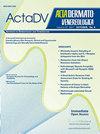下载PDF
{"title":"对接受微波设备治疗的原发性腋窝多汗症患者的生活质量、焦虑和抑郁进行评估:一年随访","authors":"Maria Pissa, Rasha Hashem, Alexander Shayesteh, Sarah Wrisley, Emanuela Micu","doi":"10.2340/actadv.v104.40543","DOIUrl":null,"url":null,"abstract":"<p><p>Hyperhidrosis is associated with social and emotional stress, affecting quality of life. Microwave energy technology treats primary axillary hyperhidrosis by thermolysis of sweat glands. The successful reduction of sweating in patients with primary axillary hyperhidrosis after microwave treatment has been studied, but there is limited evidence on the psychological and long-term effects. This study examined patient- reported outcome measures including depression and anxiety in patients with primary axillary hyperhidrosis and the effect of microwave therapy on these parameters. Patients received 1 or 2 microwave-based treatments, within 3-month intervals. All patients were finally examined at approximately 1 year after the first treatment using the Hyperhidrosis Disease Severity Scale, Hyperhidrosis Quality of Life©, Dermatology Life Quality Index, and Hospital Anxiety and Depression Scale©. A total of 103 individuals with primary axillary hyperhidrosis were included in the study, with a Hyperhidrosis Disease Severity Scale score of 3 or 4. Statistically significant improvement in quality of life, anxiety, and depression scores were observed at 1-year follow-up. The primary endpoint, Hyperhidrosis Disease Severity Scale of 2 or less 1 year after the first treatment, was achieved by 88.2% of patients. No serious adverse side effects were observed.</p>","PeriodicalId":6944,"journal":{"name":"Acta dermato-venereologica","volume":"104 ","pages":"adv40543"},"PeriodicalIF":3.5000,"publicationDate":"2024-09-05","publicationTypes":"Journal Article","fieldsOfStudy":null,"isOpenAccess":false,"openAccessPdf":"https://www.ncbi.nlm.nih.gov/pmc/articles/PMC11388111/pdf/","citationCount":"0","resultStr":"{\"title\":\"Evaluation of Quality of Life, Anxiety, and Depression in Patients with Primary Axillary Hyperhidrosis Undergoing Treatment with a Microwave Device: One-year Follow-up.\",\"authors\":\"Maria Pissa, Rasha Hashem, Alexander Shayesteh, Sarah Wrisley, Emanuela Micu\",\"doi\":\"10.2340/actadv.v104.40543\",\"DOIUrl\":null,\"url\":null,\"abstract\":\"<p><p>Hyperhidrosis is associated with social and emotional stress, affecting quality of life. Microwave energy technology treats primary axillary hyperhidrosis by thermolysis of sweat glands. The successful reduction of sweating in patients with primary axillary hyperhidrosis after microwave treatment has been studied, but there is limited evidence on the psychological and long-term effects. This study examined patient- reported outcome measures including depression and anxiety in patients with primary axillary hyperhidrosis and the effect of microwave therapy on these parameters. Patients received 1 or 2 microwave-based treatments, within 3-month intervals. All patients were finally examined at approximately 1 year after the first treatment using the Hyperhidrosis Disease Severity Scale, Hyperhidrosis Quality of Life©, Dermatology Life Quality Index, and Hospital Anxiety and Depression Scale©. A total of 103 individuals with primary axillary hyperhidrosis were included in the study, with a Hyperhidrosis Disease Severity Scale score of 3 or 4. Statistically significant improvement in quality of life, anxiety, and depression scores were observed at 1-year follow-up. The primary endpoint, Hyperhidrosis Disease Severity Scale of 2 or less 1 year after the first treatment, was achieved by 88.2% of patients. No serious adverse side effects were observed.</p>\",\"PeriodicalId\":6944,\"journal\":{\"name\":\"Acta dermato-venereologica\",\"volume\":\"104 \",\"pages\":\"adv40543\"},\"PeriodicalIF\":3.5000,\"publicationDate\":\"2024-09-05\",\"publicationTypes\":\"Journal Article\",\"fieldsOfStudy\":null,\"isOpenAccess\":false,\"openAccessPdf\":\"https://www.ncbi.nlm.nih.gov/pmc/articles/PMC11388111/pdf/\",\"citationCount\":\"0\",\"resultStr\":null,\"platform\":\"Semanticscholar\",\"paperid\":null,\"PeriodicalName\":\"Acta dermato-venereologica\",\"FirstCategoryId\":\"3\",\"ListUrlMain\":\"https://doi.org/10.2340/actadv.v104.40543\",\"RegionNum\":4,\"RegionCategory\":\"医学\",\"ArticlePicture\":[],\"TitleCN\":null,\"AbstractTextCN\":null,\"PMCID\":null,\"EPubDate\":\"\",\"PubModel\":\"\",\"JCR\":\"Q1\",\"JCRName\":\"DERMATOLOGY\",\"Score\":null,\"Total\":0}","platform":"Semanticscholar","paperid":null,"PeriodicalName":"Acta dermato-venereologica","FirstCategoryId":"3","ListUrlMain":"https://doi.org/10.2340/actadv.v104.40543","RegionNum":4,"RegionCategory":"医学","ArticlePicture":[],"TitleCN":null,"AbstractTextCN":null,"PMCID":null,"EPubDate":"","PubModel":"","JCR":"Q1","JCRName":"DERMATOLOGY","Score":null,"Total":0}
引用次数: 0
引用
批量引用


